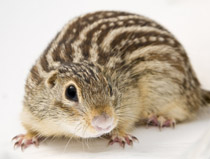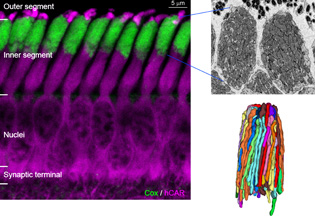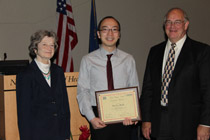Viewing the Human Retina Through the Eyes of a Ground Squirrel
NEI Scientist Wei Li Finding Strategies for Treating Human Diseases

NEI
The thirteen-lined ground squirrel ability to see in color—most mammals can’t—and to recover from the metabolic stress of hibernation may help scientists understand metabolic diseases affecting the human retina.
Why is NIH scientist Wei Li studying a fanciful species of ground squirrels to understand the human eye? For one thing, both humans and the thirteen-lined ground squirrel (Spermophilus tridecemlineatus), so named for its beautiful pattern of white stripes, can see in color. That’s something that most mammals can’t do. And when the ground squirrels hibernate, their eyes experience the same kind of metabolic stress that human eyes do when they have certain retinal disorders.
As a senior investigator at the National Eye Institute (NEI) and chief of the Retinal Neurophysiology Unit, Li studies how the synaptic circuits in the retina are normally wired and how they are altered by disease. On September 12, 2013, he presented his work at the annual Sayer Vision Research Lecture, which features scientists who have made major contributions to vision research.
The retina, the light-sensitive layer lining the inside of the eye, contains two types of photoreceptors: rods, which are sensitive to changes in light, and cones, which are sensitive to color. The ground squirrel retina and the central region of the human retina are dominated by cone photoreceptors. The retinas of most mammals are made up mostly of rod photoreceptors, which are good for night vision but cannot discern color.

NEI
Ground squirrel photoreceptor mitochondria: (left) cross section of the ground squirrel retina, focusing on the photoreceptor layer and cones; (top right) scanning electron microscopy image of photoreceptor mitochondria; (lower right) 3-D reconstruction of mitochondria in a single cone photoreceptor.
Li and NEI staff scientist Shan Chen were lauded in 2012 when they reported in Nature Neuroscience the discovery of a unique type of neuron in the retina of the thirteen-lined ground squirrel that helps encode color vision (Nat Neurosci 15:954–956, 2012). For years, researchers suspected the existence of an interneuron that modulates signals from cone photoreceptors that principally capture blue light. Li conceived of a technique to hunt for such cells among retinal interneurons called amacrine cells, of which there are 30 types. Chen painstakingly probed individual amacrine cells, measuring their response to alternating blue and green light. Li and Chen eventually found one type—the S-cone amacrine cell—that attenuates transmission from blue cones. They suspect that the newly identified cells likely have a similar function in humans.
Li also suspects that hibernation-induced metabolic stress is similar to the metabolic stress that occurs in retinal eye diseases. When ground squirrels hibernate in winter, their retinas are subjected to a long period of challenging metabolic conditions. The retinal neurons power down during hibernation, but their function is quickly restored when the animals awaken. Li wants to know how these seemingly fragile circuits rebound so quickly.
Li is using serial block face scanning electron microscopy (SBEM) to explore the structural changes that occur in the ground squirrels’ retinal mitochondria during hibernation. SBEM allows for three-dimensional reconstruction of subcellular structures through repeated fine-resolution scans. After each scan, a very thin layer (less than 30 nanometers) of the cell is cut away and the underlying surface is scanned. A computer program then assembles hundreds of scans to construct a three-dimensional representation—a little like reconstructing a loaf of bread from individual slices.
Li’s preliminary SBEM work shows that the mitochondria inside the photoreceptors look like tightly packed cable strands. He suggested that this orientation may help conduct light, similar to the way a fiber optic cable works. Li is collaborating with Robert Balaban, the scientific director of the National Heart, Lung, and Blood Institute, to correlate structural changes in the retina with functional changes such as enzymatic activity.
Li hopes that what he learns can provide a strategy for treating human retinal diseases such as diabetic retinopathy, age-related macular degeneration, and retinitis pigmentosa. Uncovering the mechanisms that ground squirrels use to recover from hibernation may help us understand metabolic stress that occurs in human diseases of the retina, Li said. “Our hope is that these tricks will point to therapeutic solutions for humans.”

NEI
Wei Li (center) with Jane Sayer (left) and NEI Director Paul A. Sieving (right) at the 2013 Sayer Vision Research Lecture.
The Sayer Vision Research Fund was established in 2006 at the Foundation for the National Institutes of Health by Jane M. Sayer, a research scientist with the National Institute of Diabetes and Digestive and Kidney Diseases, to honor her family and the memory of her parents. In partnership with the NEI, the fund supports the Sayer Vision Research Lecture Series, given by a scientist of national or international prominence in a discipline with relevance to vision research. From time to time, the fund also supports an award to a promising young NIH investigator in eye research, of which Wei Li is the first recipient. For more information visit http://www.nei.nih.gov/news/special/sayer.asp.
This page was last updated on Thursday, April 28, 2022
